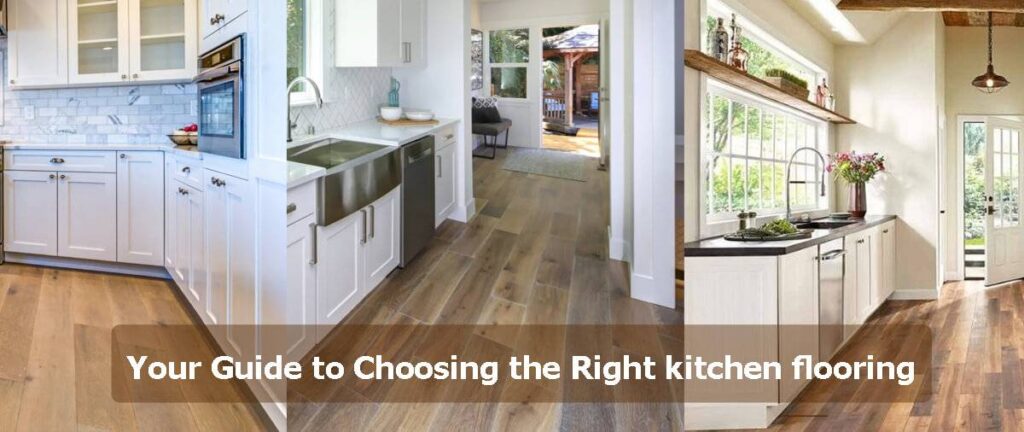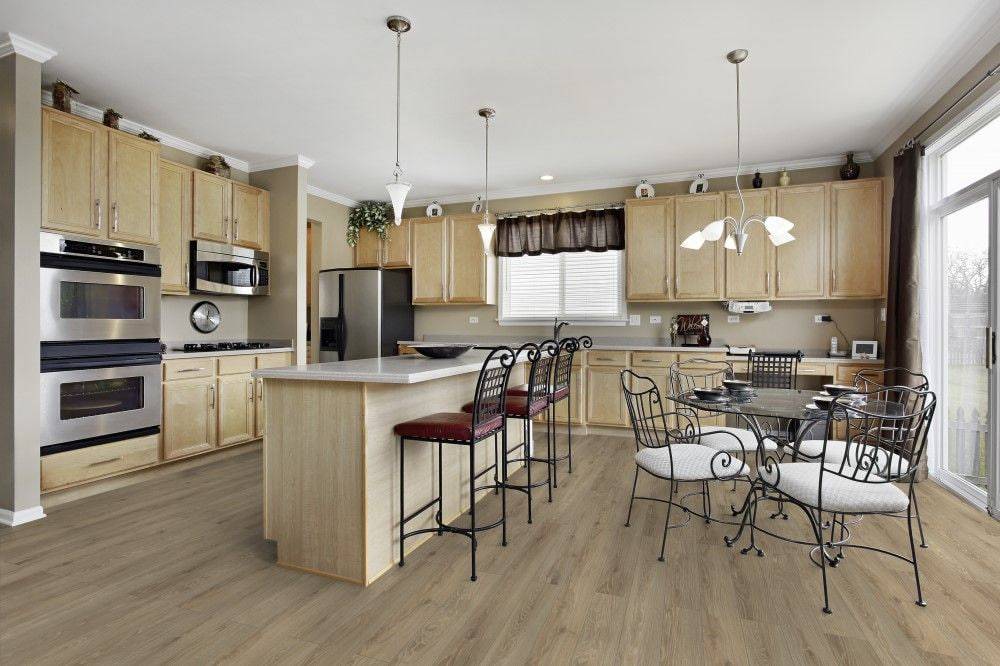Forget whipping up intricate flavor symphonies! Before you orchestrate culinary masterpieces, consider the unsung hero of your kitchen: the flooring. It’s the bedrock beneath your culinary journeys, enduring spills, foot traffic, and the constant rhythm of kitchen life. But worry not, fellow food enthusiasts! This guide is your sous chef, offering culinary insight into the exciting world of kitchen flooring.
We’ll dive into the key ingredients you need to ponder, from durability and water resistance to comfort and budget-consciousness. Explore the pros and cons of popular materials like ceramic tile, resilient vinyl, and timeless hardwood. Discover how to harmonize your flooring with your kitchen’s style, be it rustic farmhouse charm or sleek, modern haven. Plus, we’ll unveil expert tips and hidden gems to make your decision informed and inspiring.
So, ditch the rolling pin, metaphorical or otherwise, and get ready to be wowed (in the best way possible)! With this comprehensive guide, you’ll be equipped to choose the perfect kitchen flooring that complements your culinary adventures and reflects your unique style. Enjoy your next meal masterpiece!
High-Traffic Kitchens: Flooring That Withstands the Rush
Let’s discuss the first key factor in choosing your kitchen’s flooring champion: traffic volume. Your kitchen floor needs to be resilient, not just to spilled milk, but also to constant foot traffic, dropped utensils, and the lively energy of culinary creation.
Busy households? Heavy cooks? Consider these flooring warriors:
- Hardwood: Classic and timeless, hardwood offers warmth and beauty, but choose wisely. Opt for harder species like maple or oak to resist dents and scratches. Regular maintenance is key.
- Tile: Ceramic and porcelain tiles are champions of durability, water resistance, and easy cleaning. Explore diverse styles and textures to match your kitchen’s personality.
- Laminate: Affordable and versatile, laminate comes in wood-look planks that capture the warmth of hardwood without the hefty price tag. Look for AC4 or AC5 ratings for high-traffic areas.
Kitchen Flooring for High-Traffic Warriors: Comparing Durability, Ease of Cleaning, and Style
| Flooring Material | Durability | Ease of Cleaning | Style | Additional Notes |
| Hardwood | High (choose harder species) | Moderate (requires regular maintenance) | Classic, warm, timeless | Can dent and scratch, not water-resistant |
| Tile (Ceramic/Porcelain) | Excellent | Easy | Diverse styles and textures, modern or traditional | Cold underfoot, grout requires cleaning |
| Laminate | Good (AC4/AC5 rating for high traffic) | Easy | Wide variety of wood-look options | Not waterproof, can dent or scratch |
Additional Flooring Options:
- Vinyl: Affordable, water-resistant, comfortable underfoot, and offers a wide range of styles. However, it can be less durable than other options.
- Luxury Vinyl Plank (LVP): More durable and realistic-looking than traditional vinyl, with good water resistance. However, it has a higher cost than some options.
- Linoleum: Sustainable, naturally antibacterial, and comfortable. However, it requires regular maintenance and is not as water-resistant as some other options.
Flooring Harmony: Matching Your Kitchen’s Style
Your kitchen floor shouldn’t just be functional, it should be a harmonious part of the overall design! Let’s explore how to choose flooring that complements your kitchen’s unique style:
Traditional Kitchens:
- Warmth and Charm: Embrace classic materials like hardwood (oak, hickory) or stone tiles (travertine, slate) for a timeless feel.
- Pattern Play: Consider terracotta tiles or geometric patterns for a touch of country charm.
- Rich Tones: Opt for deeper wood stains or darker tiles to create a sophisticated yet inviting atmosphere.
Modern Kitchens:
- Sleek and Streamlined: Choose smooth, clean lines with materials like polished concrete, large-format tiles, or vinyl planks in neutral tones.
- Minimalist Magic: Embrace simplicity with monochromatic palettes and uncluttered patterns.
- Metallic Accents: Incorporate touches of stainless steel or brushed nickel in your flooring choice for a contemporary edge.
Rustic Kitchens: Nature’s Embrace
Bring the beauty of the outdoors inside with unpolished wood (like pine or reclaimed varieties), stone tiles (such as quarry tiles or slate), or textured vinyl that mimics natural materials. Opt for earthy tones like browns, beiges, and greens to create a cozy and inviting space. Explore artisanal details like hand-painted tiles or reclaimed wood with unique patinas for a handcrafted touch.
Kitchen Comforts: Happy Feet, Happy Cooking
Now that we’ve discussed durability and style, let’s shift our focus to comfort, an often-overlooked yet crucial factor in kitchen flooring. After all, who wants achy feet after whipping up culinary masterpieces? Here’s how to choose a floor that will be kind to your soles:
Comfort Champions:
- Cork: This natural material offers amazing cushioning and warmth, reducing stress on your joints. It’s also naturally antimicrobial and sound-absorbing, making it a great choice for both comfort and hygiene.
- Vinyl and Luxury Vinyl Plank (LVP): These resilient options come in a variety of styles and offer good underfoot comfort, especially with cushioned backing. They’re also relatively water-resistant and easy to clean, making them a practical choice for busy kitchens.
- Rubber Flooring: Often used in commercial kitchens, rubber provides excellent cushion and slip resistance. However, it may not be the most aesthetically pleasing option for all households and can require specific cleaning methods.
Comfort Tips:
- Area rugs: Strategic placement of area rugs, especially in high-traffic zones like the sink or stove, can add a layer of comfort and warmth.
- Anti-fatigue mats: Consider placing specialized mats near areas where you stand for extended periods.
- Heated floors: For ultimate comfort, explore the option of installing radiant heat under your flooring.
Budgeting for Your Kitchen Floor: Counting Pennies Before Stepping In
Now comes the practical side of things: budgeting. Kitchen flooring prices can vary greatly depending on material, quality, and installation costs. Setting a realistic budget before you start shopping will help you make informed decisions and avoid sticker shock later.
Here are some steps to consider:
- Outline your needs and wants: Define the essential features you need (durability, water resistance) and desired perks (comfort, specific style). Prioritize based on importance.
- Research material costs: Get quotes or browse online for different material options within your desired style. Remember, price per square foot is just one factor; consider total square footage and potential waste.
- Factor in installation: Installation costs can add significantly to the overall price. Get quotes from professional installers or research DIY options based on your comfort level and skillset.
- Leave wiggle room: Unexpected expenses can arise. Add a 10-20% buffer to your budget for contingencies like subfloor repairs or additional materials.
Stepping into Your Dream Kitchen: Flooring Decisions Done Right
Choosing the perfect kitchen floor is an exciting step, but it can also feel overwhelming. By considering these key factors – traffic volume, style harmony, comfort needs, and budget realities – you can confidently navigate the world of flooring options and find the one that fits your home and your heart.
Remember, there’s no one-size-fits-all solution. Embrace your unique needs and style preferences, don’t be afraid to ask for help from professionals, and most importantly, have fun creating a kitchen floor that inspires culinary adventures and joyful memories for years to come!
I hope this comprehensive guide has empowered you to make informed decisions and step into your dream kitchen with confidence. Feel free to ask me any further questions you may have – I’m here to help every step of the way!
Kitchen Flooring FAQs: Your Questions Answered
Q: What’s the most durable flooring for a high-traffic kitchen?
A: Ceramic and porcelain tiles, as well as high-quality hardwood like oak or maple, are known for their exceptional durability. Laminate with AC4/AC5 ratings can also be a good option.
Q: I’m on a tight budget. What are some affordable flooring choices?
A: Vinyl and laminate offer a wide range of styles at budget-friendly prices. Consider exploring remnant tiles for deals or researching DIY installation options to save on labor costs.
Q: I love the warmth of wood, but I’m worried about spills. Are there any water-resistant wood options?
A: Engineered hardwood is a good compromise, offering the beauty of wood with enhanced moisture resistance. Consider wood-look vinyl or LVP for water-proof options mimicking the wood aesthetic.
Q: My kitchen gets cold in the winter. Are there any comfortable flooring options?
A: Cork is a champion of comfort, providing excellent cushioning and warmth. Vinyl and LVP with cushioned backing can also be quite comfortable. Explore radiant heated floors for ultimate comfort, but remember the added cost.
Q: I’m torn between two flooring styles. How can I make a decision?
A: Order samples of both options and see how they look and feel in your kitchen space. Consider the overall color scheme and finishes of your kitchen for a cohesive look. Don’t be afraid to experiment and mix styles to create a unique and personalized space.
Q: Should I hire a professional for installation?
A: While some flooring options are DIY-friendly, professional installation ensures proper subfloor preparation and adherence to manufacturer recommendations. This can lead to better performance and longevity for your chosen flooring. Consider your skill level, budget, and the complexity of the installation before deciding.
Q: Where can I find more information and inspiration for my kitchen flooring project?
A: Numerous online resources offer articles, guides, and visual inspiration for kitchen flooring. Consulting with flooring professionals or visiting showrooms can also be helpful. Don’t hesitate to ask questions and explore different options to find the perfect fit for your kitchen!



